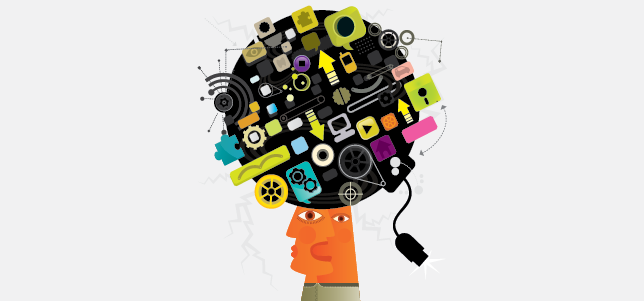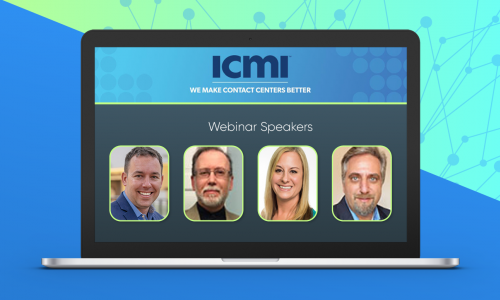In the ever-evolving customer experience landscape, technology is poised to be the primary source of disruption in 2016.
To quote Altimeter Group Principal Brian Solis, “Disruption is not something we set out to do. It is something that happens because of what we do.”
Customer experience leaders such as Amazon have been busy disrupting the market and the customer experience for years. For instance, the company provides data-driven recommendations based on a customer’s previous product purchases and expressed interests.
Disney is also a disruptor. One of the reasons customers love Disney is because of how well the entire customer experience is managed, including the logical trip planning capabilities that are offered through its MyDisneyExperience mobile app.
How can you become a disruptor this year? Here are six disruptive technologies that will transform the customer experience in 2016:
1. Smarter algorithms for more informed customer interactions. Advanced algorithms are at the forefront of delivering knowledgeable customer experiences. Machine learning algorithms are able to find patterns in customer data that people typically can’t spot on their own. Smart algorithms are enabling customer service associates to identify why a customer has reached out to the contact center and help associates deliver intelligent support. They can also learn from previous customer interactions and be used by marketers to present the best possible offer or message to a customer.
At Macy’s, advanced algorithms are melding the online and offline customer experience. They are being used to determine whether inventory should be pulled from a fulfillment center or a local store to meet a specific customer’s needs. Wall Street analysts expect the strategy will enable Macy’s to boost profits by developing targeted merchandising plans that are aimed at specific customer segments.
2. Video engagement goes virtual. From real-time streaming to virtual reality videos, video technology has made incredible strides. Video provides unique opportunities for brands to engage consumers that beat other mediums. Revenue from augmented and virtual reality video is expected to reach $150 billion by 2020, according to Digi-Capital.
Brands can use virtual reality videos to provide customers compelling experiences with their products or services. For instance, a travel agency can use virtual reality video to provide prospects with a multi-dimensional simulation of what it’s like to scuba dive along the Great Barrier Reef while an appliance maker can offer step-by-step instructions on how to drain a clogged washing machine.
3. Artificial intelligence makes voice recognition smarter. Voice recognition technology continues to get better, offering more and more uses in our daily lives, from voice-operated vacuum cleaners to voice-activated mobile applications. Voice recognition has become even more powerful as it is further enhanced by artificial intelligence (AI).
For instance, the ivee Sleek is a voice-activated personal assistant that can tell users the time, turn off the lights, change the temperature in a room and clean up a mess when it’s connected to a Roomba. Expect to see companies take advantage of additional opportunities to apply voice recognition into their products and to help streamline customer support.
4. Native advertising takes on ad blockers. Apple sent a jolt through the ad industry last year when it equipped the iPhone 6s with an operating system that allows users to install software that blocks banner ads. Since then, ad-blocker adoption in the U.S. has been growing. A December 2015 survey conducted by Digital Content Next found that 33 percent of consumers are likely to try ad-blocking software in the next three months.
Native ads, which are meant to look and function like the content surrounding them, have been introduced as an alternative to ad blockers. Native advertising is paid for by a brand on a mobile or traditional website, delivering targeted in-stream content without disrupting the user’s experience. For instance, an infographic with ‘10 things you need to know before applying for a personal loan’ could be targeted at people who have searched for loan options.
5. Customer data security spreads to the Internet of Things. A customer data breach can be disastrous for a business and its brand. Cyberattacks can result in customer defection, lost revenues, potential fines, and declines in share value. A single breach can destroy customer trust.
Customer data will become even more vulnerable as companies expand their use of the Internet of Things (IoT) to transmit customers’ behavioral and interaction data across sensors and communications devices. According to research conducted by Intel, there will be 26 connected devices per human worldwide by 2020.
As highly publicized customer data breaches have led to board-level liability lawsuits, expect companies to become more active in protecting customer data from end to end, including how customer data is transmitted, processed, shared, stored, and destroyed.
6. Customer-centric business partnerships will flourish. Companies will increasingly enter into partnerships with other organizations to strengthen their product and service offerings to customers and boost the customer experience. Partner ecosystems that take advantage of customer data and analytics can achieve a competitive edge through creating highly customized offerings for customers.
The Lyft ecosystem is a great example of this. The peer-to-peer ridesharing service has partnered with Starbucks to accommodate customers who drink coffee during their morning commute. Lyft drivers have the option of becoming My Starbucks Rewards (MSR) loyalty program gold level members while Lyft passengers have the option to earn MSR loyalty ‘Stars’ redeemable for food and beverages at participating Starbucks stores. Lyft has also formed partnerships with Shell and Hertz to offer drivers discounted gas and access to rental cars. Lyft also received a $500 million investment from G.M., part of which will go toward developing an on-demand network of self-driving cars. These partnerships work well because the Lyft ecosystem benefits all participants – customers, employees, and partners.
Technology is playing a powerful role in delivering intelligent and streamlined customer experiences. Companies that make use of cutting-edge innovations focused on addressing customer needs and preferences position themselves to deliver differentiated customer experiences that will distinguish them in the eyes of consumers.
Like this? Subscribe to our blog here.
Also, check out the most recent issue of our eNewsletter.
Six Disruptive Technologies That Will Ignite the Customer Experience in 2016


January 15, 2016
by
Digital Transformation, Data Analytics, Employee Experience, Digital Transformation Consulting, Intelligent Automation
Digital Transformation, Data Analytics, Employee Experience, Digital Transformation Consulting, Intelligent Automation





